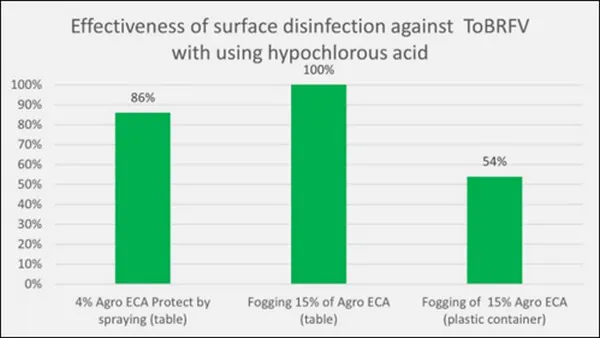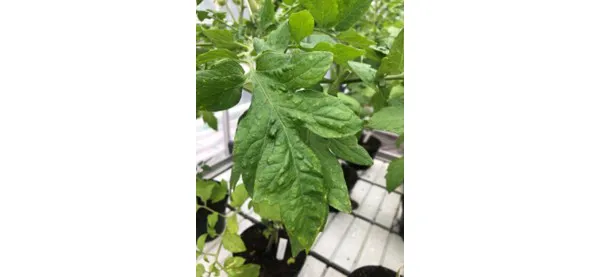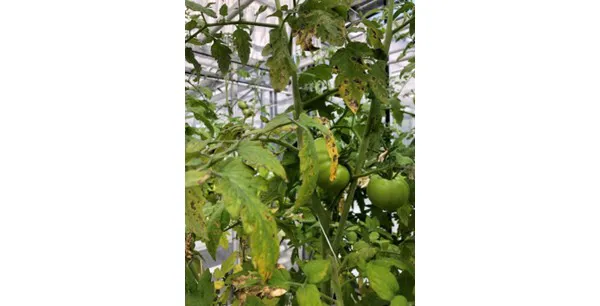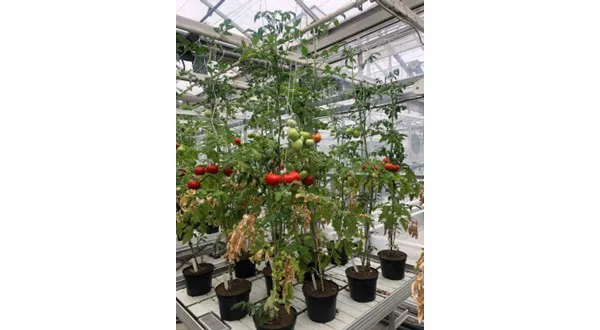According to the latest research from the National Research Institute of Horticulture in Skierniewice (Poland), hypochlorous acid limits the spread of the ToBRFV in tomato crops and significantly reduces disease symptoms on leaves and fruits.
Hypochlorous acid is one of the most effective known biocides. It is naturally produced by human white blood cells and is an essential part of the immune system. Hypochlorous acid is harmless to humans, animals, plants, and the environment.
Experiment: limiting the spread of ToBRFV in tomato cultivation
The experiment was conducted by Beata Komorowska, PhD, from the National Research Institute of Horticulture in Skierniewice (Poland).
The experiment used 2 products containing pure, stabilized hypochlorous acid - Agro ECA – registered as a biocide, and Agro ECA Protect - registered as a biostimulant and approved for organic cultivation.
Surface disinfection with Agro Eca Protect by spraying and Agro ECA used by fogging showed high effectiveness in deactivating the ToBRFV (graph).
 Graph 1. Effectiveness of surface disinfection against ToBRFV using stabilized hypochlorous acid
Graph 1. Effectiveness of surface disinfection against ToBRFV using stabilized hypochlorous acid
During the experiment, an extract from tomato leaves infected with ToBRFV was applied to the surface. Than the surface was sprayed or the greenhouse was fogged. After the treatment, the extract from the surface was dissolved in 1 ml of distilled water. Finally, the extracts were used to inoculate 50 young tomato plants. After 21 days, a sample of a single, newly growing leaf was taken from each plant and tested individually with an RT-PCR test.
Testing the effectiveness of reducing the symptoms of ToBRFV
The second research, conducted by Beata Komorowska, PhD, was about checking the possibility of reducing the symptoms of ToBRFV. Twenty-four tomato plants were inoculated with ToBRFV. Watering with a solution of Agro ECA was started after the disease symptoms appeared (photo 1 and photo 2).
 Photo 1. Symptoms of ToBRFV 2 weeks after inoculation
Photo 1. Symptoms of ToBRFV 2 weeks after inoculation
- In all tomato plants infected with ToBRFV, which were watered with stable hypochlorous acid, the tested virus was detected after 40 days of treatment.
- Despite the detection of the viruses in the plants, a significant reduction in the intensity of disease symptoms was observed during treatment – especially in the upper part of the plants (photo3, photo 4) – compared to plants not treated with the solution.
 Photo 2. Symptoms of ToBRFV 4 weeks after inoculation
Photo 2. Symptoms of ToBRFV 4 weeks after inoculation
 Photo 3. Tomatoes plants after 54 days of inoculation of ToBRFV and 40 days of treatment with Agro ECA.
Photo 3. Tomatoes plants after 54 days of inoculation of ToBRFV and 40 days of treatment with Agro ECA.
Is it possible to cure a tomato plant infected with ToBRFV?
The recent research conducted in Horticulture Institute in Skierniewice aims to check whether it is possible to eliminate the ToBRFV virus from infected young tomato seedlings. Preliminary research results show that this virus has been eliminated in some plants infected with ToBRFV. The results of these studies will be published after their completion.
For more information:
AgroSmart Lab
Niegardów 26, 32-104 Koniusza
Tel.: +48 888 606 101
info@agrosmartlab.com
agrosmartlab.com
